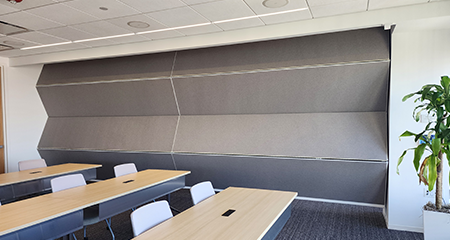Unlocking the Sound of Silence: Understanding Acoustic Testing for Operable Walls
In today’s bustling world, where peace and quiet are increasingly cherished commodities, the demand for effective sound management solutions has never been greater. Whether in corporate offices, educational institutions, hospitality venues, or healthcare facilities, the need to control noise levels and create the most suitable acoustic environments is important. This is where operable walls come into play, offering versatility, functionality, and aesthetic appeal while addressing acoustic concerns.
At Modernfold Chicago, we understand the significance of delivering not just operable walls but solutions that perform well acoustically.
Understanding Acoustic Testing
The most specified acoustic testing criteria for operable partitions is the sound transmission class (STC) rating. An STC is a standardized rating classified by ASTM E413 and is a result of comprehensive testing designed to isolate the acoustic performance of a building material, in our case, operable partition panels. The higher the STC rating, the better the material or assembly is at blocking sound. The STC testing procedures adhere to the ASTM E90 standard and are conducted in a controlled laboratory environment. The lab setting is designed to focus on the test specimen, and nothing else. This is an important point to understand and bears repeating, STC ratings are derived from lab tests that focus on the test specimen’s acoustical performance.
The classifications for sound ratings outlined by ASTM E413 can also be applied to determine similar ratings for field performance. A field rating is called noise isolation class (NIC) and is tested in accordance with ASTM E336. It is reasonable to expect the NIC rating to be lower than the STC because of various flanking transmission or construction errors that are not present in a controlled lab. Some common flanking paths are finished flooring materials, shared mechanicals, shared doorways, or adjacent wall construction. Given these construction variables, the NIC represents a collective rating of the entire construction envelope, including the operable partition. The ultimate acoustical effectiveness of an operable partition requires a properly specified STC along with careful planning and execution of the surrounding construction and quality installation. Understanding the relationship between NIC and STC and applying these principles is critical in establishing reasonable acoustical performance expectations for the finished product.
Testing Procedures
For field testing of operable walls, the operable wall is installed according to the manufacturer’s specifications and then subjected to sound testing procedures. During this test, sound is generated on one side of the operable wall, and the sound levels are measured on both sides to determine the amount of sound transmission through the wall.
In acoustic testing for operable walls, pink noise is often used as the sound source to simulate real-world conditions. It provides a standardized signal with a balanced frequency distribution, allowing for more accurate and reliable measurements of sound transmission and attenuation properties across different frequencies.
By using pink noise during testing, engineers and researchers can evaluate how effectively operable walls reduce sound across the entire audible frequency range, providing a comprehensive assessment of their acoustic performance.
Testing Technology
As the pink noise is generated on one side of the wall with a loudspeaker or other sound-emitting device, a sound level meter is used to measure the sound pressure levels on both sides of the operable wall. These meters are typically equipped with microphones that capture sound and convert it into electrical signals for analysis. The technology can provide feedback at specific locations to help evaluate and determine where any sound transmission is occurring.
Passing the Test
Once the test is completed, a report is generated to provide information about the operable wall’s effectiveness in reducing sound transmission, with the results being summarized as an NIC rating. The relationship between STC and NIC should be evaluated on a project specific basis to determine what is acceptable given the circumstances. A generally accepted standard is the NIC rating should not exceed 10 points less than the specified STC. While more demanding projects may tighten this gap, they should also be more diligent in their design and execution of surrounding construction.
Incorrect installation, inadequate surrounding construction, flanking patches, and/or poor setup of an operable wall can all contribute to sound leakage.
Addressing these challenges requires careful attention to detail during the design, construction, and installation of operable walls, as well as rigorous testing and quality control measures to ensure that the desired performance is achieved and maintained.
Tailored Solutions for Every Need
At Modernfold Chicago, we recognize that one size does not fit all when it comes to acoustic requirements. That’s why we offer a range of operable wall systems with varying acoustic capabilities to suit diverse applications and preferences. Whether you are an architect or a general contractor needing maximum acoustical separation for a boardroom or moderate noise reduction for a banquet hall, we can work with you to ensure a successful installation.
If you’re ready to transform your space with cutting-edge operable wall solutions backed by rigorous acoustic testing, contact us today. Let’s collaborate to unlock the sound of silence.



